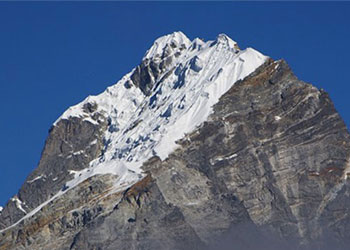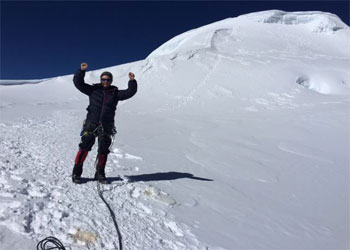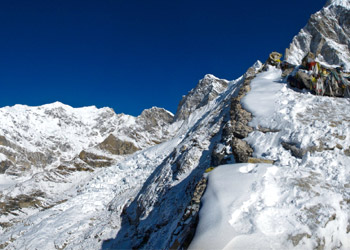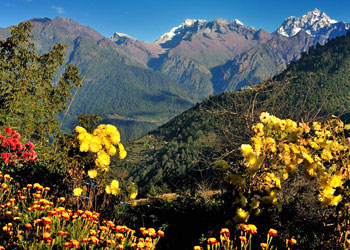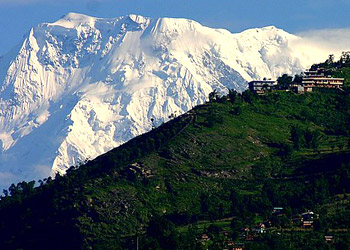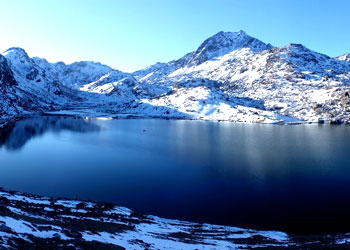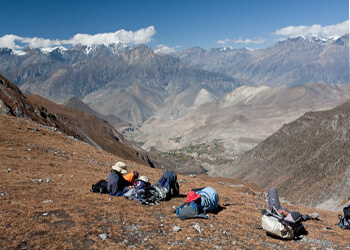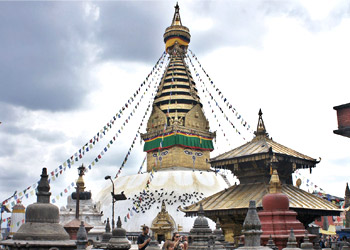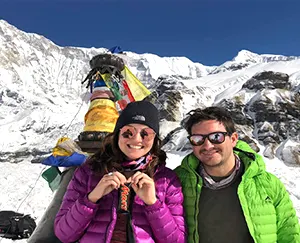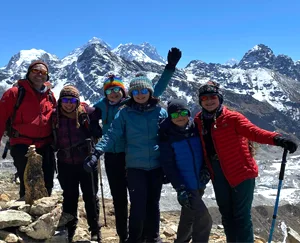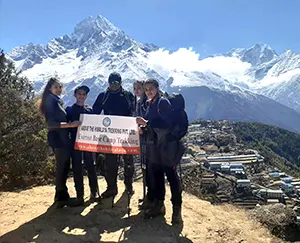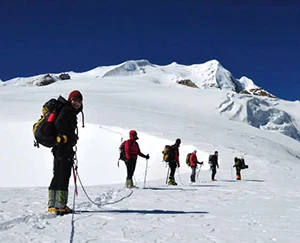Small Group Departure Dates for 2025 and 2026
Trip Highlights of Island Peak Climbing
- The trail and everything else about the island peak climbing trek is a perfect introduction to mountaineering and Himalayan trekking in Nepal.
- The panoramic view of mountains through the trail heightens Mount Everest and Lhotse, Makalu, and many 7,000 m+ peaks.
- You will also get a chance to Experience traditional high-Himalayan Gurung Sherpa culture in the towns of the Khumbu region while trekking the island peak.
- We observe different wildlife, including the Musk Deer, Himalayan Tahr, Himalayan Monal, and maybe even the Snow Leopard in Sagarmatha National Park.
- Trekking in Everest base camp, where you will experience trekking to mountains.
- As this island’s peak climbing is not that high, trekkers are less likely to suffer from altitude sickness during your island’s peak climb. But you will have to take the necessary precautions to avoid this problem.
Overview of Island Peak Climbing
Island Peak Climbing is a small and mythical trek in the Khumbu region. The Island peak, also known as Imja Tse, has an altitude of 6119 meters from sea level. In 1952 AD, Eric Shipton’s group named the mountain “Island Peak.” Its best location is in the middle of the Chhukung Valley, and it seems like it’s the island on a sea of ice from Dingboche.
The island’s peak area is the ridge extension, which comes down from the south end of the Lhotse Shar. It lies hardly 10 kilometers away from Mount Everest. This trek is a fabulous climb through green grassland. It goes along with the fabled view of Mount Everest.
This trek is for those who love Adventure Mountains in their natural form, covered by snow and ice. The highlight is a stunning view of different high mountains. You can see Pumori, Nuptse, Lhotse, and Everest’s north face from Kala Patthar.
This place is named the Island Peak because earlier, it used to look like an island in the sea of ice. Compared to other mountain peaks in Nepal, the island peak is slightly tricky to trek. This trek takes about 20 – 21 days to complete with proper acclimatization.
You must get some special training and experience to do this trek. Sir Edmund Hillary, the first person to climb Mount Everest, also has trekked this place. He traveled as an experience and training for Mount Everest. The distance between Mount Everest and the island peak is about 10 km.
Island peak climbing is an accessible peak climbing in Nepal.
You have two different options for starting the island peak climb. One is from the base camp, also called Pareshyaya Gyab, at 5,087 meters. Another option is quite famous and known to reduce the time and effort of climbing Island Peak. The path ascends to High Camp at 5,600 meters.
You might need help with a proper water supply and food in the higher altitude region. So, it would help if you planned your trek according to that. Glacier Island peak climbing travel begins from the top of the gorge. Then, the route goes up to the sloppy ice and steep snow.
There is a fixed rope set almost 100 meters to the summit for the ascent of the mountain. From the top of the island peak, you will get an exotic view of Mount Everest and several other mountains. On the side of Mount Everest, you can see cliffs like Lhotse and Mount Makalu. Island peak climbing trekking will give you a great chance to experience mountaineering.
Climbing other high mountains is best, especially for beginners. Mounting the island peak does not require exceptional mountaineering experience. The journey to the Island Peak provides a beautiful view. You can see the natural and cultural beauty of the Khumbu region. A sea of glaciers and mountains wraps the Island Peak, seven to eight thousand meters tall.
Island Peak Climbing 2026/2027
Island peak climbing trip 2026 and 2027 booking is open. You can book your island peak climbing for any mountain peak on any date. Most of our groups are small and tailor-made. You can make your climbing itinerary on a private trip or join our small group.
We operate from 2-person to 10-person groups. You can take a private trip with your loved ones or friends. Island peak climbing in 2026 and 2027 dates from Arrival to Nepal to Departure from here. We can also make the island peak climbing itinerary from Kathmandu to Kathmandu.
Itinerary of Island Peak Climbing
01
Day 01: Greetings at Kathmandu Airport, transfer to hotel.
We will meet you at the airport and transfer you to your hotel for your Island peak climbing trip. As you freshen up after your long journey, we will ask you to visit our office for a briefing about your program.
You will meet your guide to discuss the equipment needed for the Island peak climbing. We will process the trekking permits. If you arrive at night, we will have the same discussion the following day after breakfast.
02
Day 02: A full day recreational tour of Kathmandu, the capital valley
The following day of our Island peak climbing trip, you have your breakfast. We will take you on a full-day sightseeing tour around Kathmandu Valley. You will visit the center of pilgrimage, Pashupatinath Temple and Swyambhunath. They are very ancient and enlisted in UNESCO World Heritage sites.
The biggest Buddhist Stupa at Boudhnath and Kathmandu Durbar Square have fine arts and historical architecture. They will take you to the ancient Nepalese culture. While returning to the hotel, you can explore the local areas, gullies, and lifestyles.
03
Day 03: Flight from KTM to Lukla and trekking to Phakding
Early in the morning, we fly from Kathmandu to Lukla via a mountain flight of about 40 minutes. We enter the deep gorge of the Dudh Kosi valley. With clear weather, we get fantastic views of the mountains, including Everest. You begin your Island peak climbing trip from Lukla.
We will follow a gentle climb up the mountainside on the left bank of the Dudh Koshi River. You will also view Mt. Nupla (5885m), Kusum Kangaru (6367m), and Mount Kwongde Range.
We then take a leisurely walk for about two hours to Phakding village for the overnight stop. You can stroll around the town for local knowledge the rest of the time.
04
Day 04: Phakding trekking to Namche Bazaar
From Phakding, the Island Peak climbing trail follows the Dudh Koshi valley north, meandering through the pines. It crosses the valley twice by small suspension bridges before reaching the village of Monjo, the entrance gate of the Sagarmatha National Park.
Beginning with a slight climb to Jhorsalle, the trail passes waterfalls and other culturally and naturally occurring items of interest. Villages have magnificent forests of Rhododendron, Magnolia, and fir. Along the way, you get your first glimpse of Kusum Kanguru (6369m), Thamserku (6608m), Everest (8848m), and many more.
05
Day 05: Acclimatization day in Namche
Set in a natural amphitheater looking across the jagged ridge of Kongdi Ri(6187m). Namche Bazaar is one of the most attractive settlements in the Khumbu region. It is an ideal place to spend a rest day and acclimate to a high altitude before heading off. We will have a full day’s rest so that we won’t face any problems with your Island peak climbing trip.
Today, we make a short acclimatization trek to Khumjung, a delightful Sherpa village above Namche. You have a full day to enjoy a beautiful panoramic view or stroll around the market. You can also enjoy splendid views of Everest, Ama Dablam, Thamserku, Nuptse, Lhotse, Tawche, Kwangde, etc.
06
Day 06: Namche Bazzar trek to Tengboche
We follow a spectacular path traversing the hillside high above the Dudh Kosi River. After walking for one hour, you will arrive in Phungithanga. The trail climbs past some water-powered prayer wheels. Then, a sustained climb through a forest of tall, mature rhododendrons begins.
The village scatters across a vast, grassy saddle at the Tengboche’s (3870m) start. It goes below a crescent-shaped ridge covered by scrub pines and firs. From the viewpoint at the top of the hill, there are awe-inspiring views of distinctive peaks.
You can see Amadablam (6856m) standing proud of the massif containing Everest (8848m). You can also see Nuptse (7861m), Lhotse (8501m), and inspiring views of Himalayan giants. We visit the Buddhist Monastery at Tengboche, the largest in the Khumbu region.
07
Day 07: Tengboche trekking to Dingboche
In the morning, views of mountains and monasteries are spectacular in Tengboche. From Tengboche, follow the trail as far as Orsho. Then, take the lower path along the west bank of the Imja Khola. Pass through the forest of birches, conifers, and rhododendrons.
As we follow the river northward, the trails pass through chortens, mani walls, and small villages. Today’s Island peak climbing walk offers views of Mt.Tawache and Ama Dablam. To the north, you can see Pokalde (5741m), Kongma-Tse (5820m), and the high wall of Nuptse.
Dingboche is also the gateway to Chukung. It is farther beyond for the most challenging traverses towards the Makalu area. We enjoy the beautiful fields enclosed by stone walls. The walls protect the barley, buckwheat, and potatoes. Overnight stay in Dingboche.
08
Day 08: Rest day in Dingboche for the acclimatization
Spending an additional night here is essential to aid the acclimatization process for Island peak climbing. It can be a short 400 m hike to Nangkartshang Gompa on the ridge north of Dingboche. From here, you can enjoy an excellent view of Makalu (8463 m).
You can go for a day walk. A trek to Chhukung (4,730m) is worthwhile, and it takes approximately 4/5 hours from Dingboche, but it might ruin your rest. To the north of Dingboche are spectacular views of Lhotse’s massive South Face.
09
Day 09: Dingboche Trekking to Lobuche
The Island Peak Climbing Trail follows a downward path to Pheriche village. It joins the course below, with beautiful views of Cholatse across the valley. After another steep ascend, the trail climbs up. It goes over the terminal moraine of Khumbu Glacier. The path follows a pleasant, grassy valley.
Stark and rugged beauty creates an almost moonscape campsite at Lobuche. It is a windswept collection of huts tucked in a narrow meadow between the glacier and the Lobuche peak. Tawoche and Nuptse are particularly spectacularly from Lobuche towering. Stay overnight at the lodge.
10
Day 10 : Lobuche to Gorakshep, trekking to Everest Base camp, and back to Gorak shep
The first section of the trail from Lobuche follows the narrow gap between the glacial moraine and the mountain walls. It goes past the turn-off to the Italian pyramid. Take time to detour to the edge of the moraine to look over the Khumbu glacier. Along windy and rocky paths with a beautiful view of Mt. Pumori, Nuptse, and other magnificent peaks, we reach Gorakshep.
Gorakshep is the location of the original Everest Base Camp. The new camp is further up the valley. After lunch, our adventure continues towards Everest Base Camp. The trail passes through over rocky dunes and moraines and streams. The Base Camp area provides a chance to experience the freezing and harsh conditions.
The mountaineers must be brave to summit this famous mountain. At Everest Base Camp, the climbers gather to summit Everest during the high expedition season. We explore the base camp and its surroundings, glacier, and return to Gorakshep.
11
Day 11: Gorak Shep trekking Kala Patthar and back to Lobuche
Mornings are usually sparkling and bright. This is the best time to climb Kalapathar for one of the world’s definitive mountain views. We will get 360-degree dramatic panorama views of Mt Everest.
We see surrounding mountains like Mt. Pumori, Mt. Lingtren, Mt. Khumbetse, Mt. Nuptse, Mt. Lhotse, Mt. Ama Dablam, and Mt. Thamserku, along with many other peaks. You will have an easy walk for about 2 hours to reach Lobuche. Stay overnight at the lodge.
12
Day 12: Lobuche to Dingboche
The Island peak climbing trail follows an upward path from Pheriche village. It joins the course below with beautiful views of the cholatse across the valley. Today’s walk offers views of Mt.Tawache, Ama Dablam, the north-Pokalde (5741m), Kongma-Tse (5820m), and the high wall of Nuptse.
The path follows a pleasant, grassy valley. Dingboche is also the gateway to Chukung. It provides the trail farther beyond for the most challenging traverses to the Makalu area.
13
Day 13: Dingboche – Chukung
Today, the trail gently goes from Dingboche to a wide valley without green trees and forests. We descend gradually. Then, walk up the Imja Khola valley to Chukung before the town of Island peak climbing. It is a small summer settlement. We will meet the climbing staff for Island Peak climbing. Overnight in Chukung, where we make final preparations for Island Peak Climbing.
14
Day 14: Chukung – Trek to Island Peak Base Camp
The path from Chukung leads reasonably steeply to Island Peak, climbing south. Then, it turns east to the main line of the valley. It then storms slung or underneath the south side of the valley from the Lhotse Glacier.
The Island Peak climbing trail follows the moraine of the Lhotse Glacier to the snout of the Imja Glacier. It then branches to the east and skirts around the base of Island Peak. Stay overnight at Island Peak Base Camp.
15
Day 15: Island Peak Base Camp High Camp, Summit and back to basecamp
Today, we will move a trail of Island Peak climbing to Island Peak High Camp. The path leads up beyond base camp for a hundred meters before striking off left up the steep hillside. As you climb the hill, you will see that the slope narrows, and the path enters a vertical rock channel.
From here, the route follows a ridgeline. It leads to an exhilarating and exposed traverse onto the snout of the summit glacier. A 60-meter-high wall is the only difficulty of the expedition. A final ridge leads to the summit of Island Peak.
The hill is a classic, leading quickly to the east up to the main summit at 6189m. From the summit, there are fantastic views across Lhotse to the north and the Amphu Lapcha. Mera Peak is to the south, and Ama Dablam is to the west. After congratulations and photos, we then headed back to base camp.
16
Day 16: Island Peak Base Camp to Tengboche
After our island peak climbing, we will have a long day’s journey back to Chukung and Tengboche. During the Return pathwork, we will catch some missing views of the Everest range.
Descend out of the alpine desert and back into pine forest landscapes. Walk down to the valley, where the trail is shallower through alpine meadows. The path leads to a steep uphill climb into Tengboche.
17
Day 17: Tengboche to Namche
Tengboche offers splendid views of Mt. Amadablam, lush green hills, and the river. Cross the suspension bridge over the Dudh Koshi River. Then, trek onwards to Kyanjuma. It is the junction of the Trinity Ways to Gokyo Valley, Khumjung Village, and Namche Bazar.
You can find dense wildlife in abundance inside the rhododendron forest. You can see some species of Pheasants, Himalayan Griffons, Musk deer, and wild goats. The evening explores the small surrounding area with magnificent scenery.
18
Day 18: Namche Bazaar trekking to Lukla via Phakding
The descent from Namche to the Dudh Koshi can be the most challenging stage of the entire trek. The trail descends over the ridge past rocky cliffs. It scatters pines to the tiny village of Toktok. We will work through rhododendrons and pine forests. You get a view of distant snow-covered peaks before arriving at Phakding.
It will be another 3-hour easy and gentle trail back to Lukla. The island’s peak climbing trail drops steeply and runs level throughout the day. You will enjoy the lush green scenery. You pass through incredible mountain scenery and a local Sherpa village. Finally, we will arrive in Lukla. You’ll have time to stroll around the local areas.
19
Day 19: Flight from Lukla to Kathmandu
After your success in climbing Island Peak, say goodbye to our porters. We will have an exciting one-hour flight back to Kathmandu. (It can also be an extra day in case of bad weather in Lukla, which delays and cancels the Lukla flight.)
In the evening, you can have your last night in Nepal. Enjoy the Nepali cultural dinner show. Exchange greetings among friends and with all Nepalese people. You can buy some souvenirs.
20
Day 20: Farewell Departure
Today is free or at the last minute after your island’s peak climbing. You have a few hours of unique shopping for your relatives. If you have more time, you can go shopping or sightseeing. We will drop you off at the International airport to catch your flight back to your home and wish you a safe journey.
Trip Extension
Suppose you have more time in Nepal after this trip. In that case, we can help you to extend your trip by running different treks in Nepal, tours in Bhutan and Tibet, Jungle safari tours at Chitwan, Bardia, and other National parks, Nepal luxury hotel booking, Rafting, Ultra-light flights, or any other travel-related services. You can get more information here.
Includes/Excludes
What's Included?
- Airport / Hotel / Airport transfers by private car.
- Hotel Accommodation in Kathmandu, including breakfast.
- Kathmandu city tour with English-speaking tour guide and private vehicle
- Trekking/peak climbing guide (trained in Wilderness First Aid & altitude sickness) and Supporting Staff with their food, accommodation, salary, equipment, accidental insurance, clothing, and medicine.
- All meals during trekking/peak climbing 3 meals a day (Breakfasts, Lunches, and Dinners).
- All necessary camping gear like two men’s tents, kitchen tent, kitchen equipment, and mattress while climbing period.
- Group medical supplies (first aid kit will be available)
- All necessary paperwork and national park entry permits.
- Climbing permit for Island Peak
- Climbing equipment like ice ax, Ice crew, snow bar, climbing rope.
- Travel& Rescue arrangement
- Round trip flight ticket for Kathmandu Lukla Kathmandu
- Above the Himalaya duffel bag. ( If you need it too, please let us know before you book the trip and remind us before you arrive here.)
- Comprehensive pre-departure information
- Above the Himalaya Gifts
- Welcome/Farewell Nepali Dinner in Kathmandu
- All necessary paper works, office Service charge, and all Government Taxes
What's Excluded?
- Lunch and dinner in Kathmandu
- Nepal entry visa fee: you can get a Nepal visa upon arrival at the Airport.
- International Airfare/Airport tax, City tour Sightseeing entry fees.
- Alcoholic and hot and soft drinks
- Personal expenses include laundry, telephone calls, sweets, snacks, beverages, bar bills, and camera battery charging.
- Travel Insurance covers both rescue and medical assistance.
- Personal trekking gears
- Tips for tour/ trekking staff and driver
Things to know before Island peak climbing
- Be prepared for the trek, i.e., take proper mountain Island peak climbing training, yoga, and different exercises to help complete this trek efficiently.
- Buy your equipment as it will be new and be more comfortable. You can buy Island peak climbing equipment in Kathmandu, which will cost less.
- You will have to hire a porter to take care of your bags and luggage for the entire trek, as it is long, and it won’t be easy to carry bags throughout.
- Manage your safety yourself for the entire trek. As mentioned above, the weather conditions of the island peak are icy, so wear warm clothes throughout the trek and wear a helmet and safety equipment while climbing the peak.
- Always listen and follow the instructions given by the guide while trekking.
- Gears and equipment list
- Island peak climbing is challenging. Walking on the rocky terrain might be painful for your feet, so you must carry a pair of trekking boots.
- Make sure you carry Good gloves to keep your hands warm while trekking. Also, remember that the gloves must be very comfortable as you must take mountaineering equipment.
- Always carry a water bottle with you. It is essential to keep your body hydrated in high-altitude places like island peaks. Also, take a water-purifying tablet with you.
- While island peak climbing, you will be connected to a rope with your guide. So you will need to carry a rope with you. Different types of ropes are available in the market, but dynamic ropes are preferred for climbing mountains.
- A well-fitted harness is required for the island peak. Ensure that the harness you will use is comfortable and easy to apply.
- As you will be Island peak climbing in the mountains, you might have to camp in the hills, so carry a sleeping bag.
The following is some advice for the Island Peak Climbing Equipment list. You can choose the packing list per your interest, elevation, season, and requirements. Most of the equipment can be hired in Kathmandu. Remember to pack light.
Climbing gears
- Climbing harness
- Ice ax
- crampons
- Mountaineering boots
- AscenderDescender/Abseil device
- Rope
- Snow bar
- Ice hammer
- Helmet (optional)
Clothing
- Sun hat or scarf
- Fleece jacket with wind-stopper
- Waterproof shell jacket
- Down jacket (you can hire in Kathmandu also)
- Lightweight and Heavyweight gloves or mittens with a waterproof shell outer for Mera peak climbing.
- Light and expedition-weight thermal bottoms
- Fleece or wool pants
- Waterproof (preferably breathable fabric) shell pants
- Thick, warm wool hiking socks
- Hiking boots with spare laces
- Sunglasses with UV protection
Accessories
- Sleeping bag rated to zero degrees Fahrenheit
- Trekking poles (sticks)
- Headlamp
- Trek rucksack or duffle bag
- Basic First Aid Kit
- Daypack (35 to 50 ltr)
- Thermo-rest sleeping pad
- Water bottles
- Small wash towel
Toiletries
- Quick-drying towel (medium-sized)
- Soap (preferably biodegradable)
- Toothbrush/paste (preferably biodegradable)
- Deodorants
- Face and body moisturizer
- Nail clippers
- Small mirror
- Tissue paper/ toilet roll
- Anti-bacterial Hand wash
Extras/ luxuries
- Trail Map/Guidebook
- Binocular
- Reading book
- Journal & Pen
- Pencils and small notebooks
Others
- Snack Foods (Bring snacks and foods you like to munch)
- Travel clothes to wear in Kathmandu
- Sleeping bag (-20 degrees sleeping bag)
- Inflatable mattress
Best Time for Island Peak Climbing
For Island peak climbing in Nepal, we have the best two seasons in Nepal. Autumn and spring are the best times for Island Peak climbing. The Island Peak climbing between October and November or March and May is perfect.
The weather is clear during this time, and the day is long in spring. But you must always wear suitable climbing clothing. The temperature is low and freezing after the Island peak base camp. The weather after base camp is unstable. Occasionally, the bad weather and the cool temperature add a thrill to the adventure.
Furthermore, for them to safely climb to Island Peak, we need dry and stable weather. Strong winds and snowfalls might double the difficulty of the climb. So, to avoid these problems, we must choose the right time for the climb.
Flight delay/cancelation and changes in the Island Peak Climbing itinerary
Lukla flights rely on weather conditions, sometimes leading to delays or changes. We constantly endeavor to make sure you reach your destination on time. And for our island peak climbing, we will re-arrange your ticket for the next available flight.
If Lukla’s flights are delayed, the client must bear all extra expenses, including food and accommodation costs. If you wish to make alternative arrangements, you will have to pay all other fees. To avoid flight delays, you can take a Helicopter flight.
Suppose a flight delay to Lukla on this island’s peak climbing. We will try to book the same hotel you use in Kathmandu on your arrival day. We will look for other hotels if it is unavailable until we confirm your flight. We will adjust the itinerary to ensure you get as much time as possible in the mountains.
This situation may mean reducing/removing the Kathmandu nights at the end of the trip. If the flight from Lukla to Kathmandu gets canceled, you must also cover the extra night cost and food. We will rebook your flight for the next day. If flights can not operate due to terrible weather, regular flights cannot work.
In such cases, we can assist you by providing a helicopter service for peak climbing on your island. You must pay this extra cost (less the regular flight ticket price). You can claim this from your insurance company upon your return to your home country.
Trip extension
After you have finished your island peak climbing, you can do other activities in Nepal if you have more time. You can go to Chitwan National Park for a jungle safari tour or a day Hiking trip. Pokhara is famous for adventure activities like paragliding, ultralight flights, and bungee jumping. We can arrange other tours and make these extra activities optional.
We have yet to include it in your package cost. You can arrange these activities with us at a reasonable discounted price. If you need hotel or flight ticket services after the trek, we can set them at a reasonable cost. You can also tour Kathmandu city or join a 1-hour scenic flight over Mount Everest. Furthermore, we also offer Tibet and Bhutan tours.
Island peak climbing is a popular peak climbing activity in the Everest region.
This adventure allows you to behold the never-seen-before locations. You can see mountains and glaciers. You can opt for backpacking on famous mountain trails. The island’s peak climbing lets you enjoy the fantastic view of Mt. Everest. You can view several other similar peaks. You can explore Buddhist monasteries and shrines along with extraordinary wildlife.
The path, Chukkung RI, and Kalapathar open up classic views of icefalls and glaciers of the Mahalangur Himalayan range. Imja Tse/Island not only provides an enjoyable climb but also offers stunning scenery of the Himalayas in the Khumbu region.
You can view Mt. Everest 8848 m, Mt. Nuptse 7,855 m, Lhotse 8,516 m, Makalu (8475 m) in the east, Baruntse 7720 m, and Mt. Amadablam 6856 m in the south. This island peak climbing expedition offers terrific trekking through the high Khumbu region. It fits an enthusiastic person. If you are excited, then you are welcome to join the team.
You get the sensational views of high snow-capped mountains and dramatic landscapes. There are verdant steep valleys, Buddhist culture, and warm, friendly hospitality of Highlanders. There are pristine lakes. You get stunning views in the heart of the world’s heritage ‘Sagarmatha National Park.’ These are the critical traits of Island Peak climbing. It will be your once-in-a-lifetime experience.
Get our best package for Island peak climbing.
You can observe centuries-old Nepalese and Tibetan cultures during this trek. You will notice the superb mountains, glaciers, and backpacking views. You go through famous mountain trails. You go through different remote villages of the Khumbu region. You pass Tokyo, Namche Bazar, Dzongkha, Tengboche, and Chukung.
It will bring you closer to the local people. You will spend two nights in the island peak base camp. From there, you will have a panoramic view of the high snow-peak mountains. This trek also allows you to see rare animals like pheasants, Himalayan Griffons, and Musk deer. Sagarmatha National Park is also included in this trek. UNESCO enlisted it as the world’s heritage site.
The best season for trekking to the island peaks is from March to May (spring) and September to November (autumn). We will arrange the best package for island peak climbing for you. Island Peak Climbing is one of the prominent climbing peaks in Nepal, with an altitude of 6,189 meters. Island Peak is also commonly known as Imja Tse.
Many high mountain peaks surround this peak, like Mera Peak, Pokalde, Louche East, and Mt. Everest. The Island Peak appears as an island in a sea of ice when viewed from Dingboche. That is why this peak is named Island Peak Climbing by Eric Shipton. This peak is also known as a “trekking peak.” It is one of those few mountain peaks in Nepal that are accessible without the logistics of a particular operation.
The trek can be a simple mastery of winter and trekking skills. Most trekking peaks in Nepal can be done within 1 or 2 days, but many technical difficulties can make it hard. An experienced team familiar with climbing techniques ascended Mount Everest in 1956. This submission falls on the moderate level of trekking because of the ice and snow all over the trail.
You can view mysterious mountains like Ama Dablam (6,856) and Makalu (8,481 m). The ascent to the island peak might be strenuous for the trekkers, but the descent is easy and fast. While trekking at the island peak, you can walk through the countryside. You can immerse yourself in the old centuries of Gurung, Sherpa, and Tibetan cultures.
How to get there?
Island peak climbing generally starts from the flight from Kathmandu to Lukla. After arriving at Lukla airport, you will trek toward Manju village. Manju village is at an altitude of 2750 meters. You will travel from Manju village to the famous Namche Bazar the next day. On the trail to Namche, you will go through the banks of the Dudh Kosi.
You cross it twice by small suspension bridges. After 5 hours of walking, you will finally reach Namche Bazar. The next day is the acclimation day at Namche Bazar. You can trek a little upward from the Namche Bazar to witness the panoramic view of the mountains. Sherpa Museum is also a famous place at Namche Bazar. Here, you can observe the culture and origin of the Sherpa people.
The following day, you will be trekking to Tengboche. From Tengboche, you will get an outstanding view of mountains like Mt. Everest, Nuptse, Lhotse, Ama Dablam, Thamserku, and Kwangdepeaks. The nightlight of Tengboche is the Tengboche Monastery, the oldest monastery in Nepal. People believe that the sanctuary dates from around 300 BC.
From Tengboche, you will head toward Dingboche. The path to Dingboche goes through birch, fir, juniper, and rhododendron forests. It provides a magnificent view of Pangboche village. The second acclimation day is at Dingboche. From Dingboche, you can hike for about an hour to reach Nangkartshang Peak (5,050 m). From here, you will get the first glance of the island peak, and you will have to trek toward Dingboche.
After that, you will travel to Lobuche. The route goes through a pleasant walk through the meadow that will reach Thukla. After walking a couple of hours from Thukla, you will get to Lobuche. The next day is the most exciting part of this trek, as you will trek to Everest base camp via Gorakshep. From Lobuche, you will travel to Gorakshep. It is mainly known as the place that provides the best view of Mount Everest.
Trip difficulty
The island peak climbing trek is the most challenging in Nepal. You must acquire some special physical training and exercise before trekking this place. We must understand the risk as this place falls in an extreme altitude region. Suppose you have breathing difficulty during the trek. Your oxygen level decreases with the increase in altitude.
Carrying a pair of trekking boots will be very helpful for this trek. The route to this trek is relatively easy to walk; however, you will need a lot of energy. The starting part of this trek is tricky, so once you reach the glacier field, you will have to wear crampons and rope–up. Some common difficulties faced during this trek are as follows: –
Altitude sickness
Altitude sickness is also known as mountain sickness. It is a condition of the body that causes hyperventilation, nausea, and exhaustion due to lack of oxygen. The Island peak climbing is 6119 meters. So many people will likely have altitude sickness during the trek.
Dizziness, Vomiting, and Nausea are the common symptoms of altitude sickness. If you feel any symptoms of altitude sickness, then the slower you slower your trek. To minimize this problem, you will have to keep your body hydrated.
Island Peak Climbing Difficulty
Island peak climbing requires trekking training along with physical exercise before trekking. This trek is arduous to climb because of snow all over the trail. While rising, the guide will link you with a rope, but only trust that rope connection partially. Having a rock climbing experience might be helpful for this trek.
Frostbite
Frostbite is a skin problem caused by freezing skin and underlying tissue. Frostbite can happen in the hands, legs, and ears due to extreme cold. The average temperature on the island peak climbing is -15 to -20 degrees Celsius. To minimize frostbite, keep your body warm and not reveal any body parts.
Food and accommodation during Island peak climbing
The island peak-climbing trek goes through different villages. You will always have a place to stay and eat. You will find a variety of food in the lower altitude region. But as you reach the Khumbu region, you will find little variety. We can have Nepali, Sherpa, and Western food like chips during this trek.
You must eat the right food, which gives you the energy for trekking. Besides, there are many shops throughout the trail. They provide snacks, sweets, and chocolates. You will be very comfortable with the hotel’s ad lodges in the Khumbu region. You must carry adjusting sleeping bags for any season as you will be camping in the mountains.
You will need a foam mattress for camping. Also, hotels and lodges might be full during peak seasons like spring and autumn, so remember to book your trek early. Ensure you eat warm food, which will help you complete this trek quickly. Moreover, drinking lots of water will help you achieve this trek quickly.
Everest base camp trek to island peak climbing
Trekkers prefer the combo of a trek to Everest base camp and climbing the island peak in the same hike. But this trip will be a lot more challenging for beginners. Trekking to the world’s highest mountains and climbing one of the famous climbing peaks in Nepal is very exciting. This trek will take you through Kalapatthar.
From here, you will view the entire north face of Mount Everest and several other mountain peaks. From Gorakshep, you will hike toward EBC. Your next trekking destination is Dingboche. From Dingboche, you will trek toward Chhukung Valley. From Chhukung, you will have to prepare yourself to climb Island Peak.
You can buy trekking gear and other equipment for climbing the island peak here. From Chhukung, you will trek to Island Peak. The weather conditions in the island’s peak area are icy. From the island peak, you will travel to a high camp. You will see that the slope narrows, and the path enters a steep rock.
From the high camp, you will climb the summit. You do the Island peak climbing via the ropes and follow your guide’s instructions. After climbing the summit, you will trek back to Namche Bazar. From Namche Bazar, you will take a flight to Lukla and Kathmandu.
Summit day: standing at the top of the island peak climbing.
The major highlight of island peak climbing is standing at the top of the island peak, which is at an altitude of 6,189 meters. From the top of this peak, you will get the closest view of the mountains. You can see Makalu (8475 m) and Baruntse (7129 m) in the east and the famous expedition peak of Ama Dablam (6812 m) in the south.
This peak is physically challenging and a bit hard. But once you stand at the top of the island peak, you will forget all the pain and difficulty. You can take pictures and enjoy the view of the mountain all around.
Tips for Success Island Peak climbing
- Hire a qualified guide.
A guide is essential for trekking to the island peak climbing. Suppose you are associated with any trekking company. They will provide you with an experienced and registered guide. But there are lots of local guides in the Khumbu region who need to be qualified. Your entire trek depends upon the guide you hire, so make sure that guide is well-qualified.
Though hiring a guide is not compulsory, we suggest employing one. Many unwanted problems may arise during the Island peak climbing, so a guide might help. The guides for island peak climbing are professional climbers who will help you.
- Get the right gears.
You must carry the right gear to make your Island peak climbing successful. Gear is the most important thing while trekking to the mountains. Your treks might only succeed if you pack your gear. It would help if you carried a climbing helmet and boots for hiking the island peak and had crampons, climbing harnesses, ascending devices, or Jumar.
It would help to have a descending or belay device, a Tape sling, Carabiners, a Prusik loop, and an Ice ax. Some of the trekking companies will provide you with crampons and climbing harnesses. But please buy your own. Also, for clothing for this trek, carry lightweight clothes and gloves.
- Make your schedule flexible.
While planning your Island peak climbing, you must make your trekking days flexible. The altitude of the island peak is in the danger zone, so you will need acclimatization while trekking. You will have to stroll to reduce altitude sickness.
You may have to extend your trekking days, depending on the temperature and weather conditions of the place. If you have any health-related issues, proper acclimation is the best solution until you feel better.
- Remember, safety comes first.
Island peak climbing is a risky activity. Some hazards might occur on the trail to the island peak climb trek. If you feel any uneasiness or sickness, stop the expedition. You can only complete the tour if you are healthy and energetic.
To cover the risk, you will have to get insurance. Different companies provide insurance for trekking to island peaks. You can choose the insurance according to your wish. If you travel with us, we will find you a good insurance company.
- Prepare for the trek early.
To trek island peak climbing, you must know different types of knots. It would help if you experienced camping and hiking before traveling to the island peak. You should know how to use trekking kits before trekking. Also, it would help if you learned about rock climbing. Having a particular type of physical training is very important. Taking a mountaineering course can be very helpful to complete this trek.
- Have a positive attitude.
Before submitting to Island Peak Climbing, you must be mentally fit for the trek. A positive attitude while trekking the island peak will be constructive. You can enjoy this trek more if you have a positive mind while hiking. The island trek is indeed the most difficult in Nepal. But with the right attitude and enthusiasm, you will complete this trek quickly.
Most Asked Questions by Travellers
The best time to trek the island peak with the Everest base camp is between September and the end of May. During these months, the weather in the Island Peak area is best for trekking. The temperatures of the island peak are pleasant.
Most days are dry and sunny, which helps complete this trek efficiently. Precipitation is much less during this time of the year. You can enjoy this trek because there is no chance of delay. You can also observe the best views of the mountains.
Of course, the island peak is safe to trek despite some difficulty. So, the safety and comfort of the trekkers throughout the trek are high. Besides that, you can minimize some of the challenges of this trek by taking pre-trek training.
We will provide you with an experienced and trained guide. While at Island Peak, you will be knotted tightly with your trekking guide. Always follow your guide’s instructions, and you can complete this trek quickly.
While traveling in the mountains, you must carry many things with you. For this trek, it would help if you took Climbing boots, a Backpack (daypack), and a Sleeping bag. You should also have a Head Torch, a Waterproof and windproof jacket, Shirts and T-shirts, and Thermal base layers. You should also carry a sun hat and sunglasses, Gloves, Thermal bottoms, Socks, and Trekking trousers.
You must have Water & windproof trousers, Water bottles, Sun cream & lip balm, and Personal toiletries. It would be best to carry a Tape sling, Gloves, Carabiners, and Prussik loop for trekking. It will help if you take an Ice ax, Climbing Harness, Ascending, and Descending devices. It would help if you had crampons, climbing helmets, and boots.
There are many courses and training that you can take before trekking to the island pea. However, it is not a compulsion for this trek. The activity you should do to prepare for your island peak climbing trek depends on your fitness level and medical conditions.
That is, if you are physically strong, then you do not need to take training. Some yoga and essential physical exercise will be enough. But you must take some climbing courses if you are not physically strong. For climbing island peaks, you can do activities at least five times per week, an hour each time. You can do hill walking, cycling, and strength work.
There are fewer facilities in Nepal’s higher altitude areas. A limited number of hospitals or medical services kits are on the trail to Island Peak. So, while hiring a guide and trekking, companies check whether they have passed the medical course.
Trekking guides are well-trained for any emergency. The priority is the health and safety of trekkers. If a fellow trekker in your group needs to descend, an assistant guide will accompany them. If serious emergencies arise, then evacuation would be by helicopter.
Island Peak is achievable for most people. Though climbing an island peak is hard, it is worth it after you get a view of the high mountains. It would help if you made a positive frame before trekking. However, you require adequate preparation for the trek.
Physical and technical training is essential before the trek. Rock climbing, mountain climbing, and camping experience will be helpful for this trek. Physical exercise, including swimming, yoga, and basic training before three months of the trek, will be beneficial.
Also, this trek requires more time to complete. So make sure that you plan it so that you will have 2 -3 days to adapt to the temperature. Trekking Island Peak is not for people with breathing or other health-related problems.
Reviews on Island Peak Climbing
![]()
![]()
![]()
![]()
![]()
Based on 300+ Reviews

Yasuo Oda
Japan
Best guide for Island peak climbing
I have safely returned home last morning. I am pleased to write my comment as follows.
My trekking guide, Phurba-san, was excellent. He always cared for this 60-year-old. He arranged practically a private room at each lodge for my comfort. He helped me a lot, mainly when I had a portion of bad food.
I also appreciated his work securing a return flight despite the cancellation on the previous date. Thank you for giving me a perfect climbing guide, Lhakpa Sherpa. I am happy you will follow my suggestion for climbing for your next trip.
I suggest having your climbing guides use a satellite mobile during peak climbing. They are primarily out of regular mobile ranges.
Anyway, I enjoyed it very much.
Many thanks, Puru-san, for the trip.
Yasuo Oda

Sota Sakai
Japan
Island peak climbing with best guide
I wanted to go alone to Island Peak, 6,200m, a trekking peak located south of Lhotse. I searched on the Internet and found Above Himalayan Trekking. I often spoke over the telephone with Puru, the Managing Director, and asked to arrange the trip for 25 days.
Puru was a young man in his late twenties, and I was unsure. But he set up a trekking guide, Phurwa Sherpa, and a climbing guide, Lakupa Sherpa. Both were reliable, and I was finally satisfied. At that time, I was 60 years old, and on my first trip to Nepal, I gave up at 5,900m, which was the limit of my power. It was an unforgettable day.
Years later, I tried Lobche East 6,100m, a trekking peak located west of Lobche village on the way to Mt. Everest, and asked Puru to arrange a personal trip for 25 days. The trekking guide was Phruwa Sherpa, the same as before. The climbing guide was Cetem Sherpa, a resident of Lobche.
This time, with suitable support, I climbed to 6,070m, almost to the summit, and safely returned. It was very satisfactory.
Book with Confidence
- Flexible bookings and easy trip date changes
- Personalized service and customized group sizes
- Safe travels with owner-operated services and highly experienced guides
- Best price guarantee for the most value for your money
- Secure & easy online booking
Your Trek Leader
 Enjoy Himalayan scenery with the help of Nepal’s best guides with Government license holders and got training in first-aid, our Trip Leaders, know where you’ll find the best photos, most fascinating wildlife, and the best stream crossings.
Enjoy Himalayan scenery with the help of Nepal’s best guides with Government license holders and got training in first-aid, our Trip Leaders, know where you’ll find the best photos, most fascinating wildlife, and the best stream crossings.
 Have Questions?
Have Questions?Talk to Expert
Meet Mr. Purushotam Timalsena (Puru), Nepal's best trek and tour organizer, who has been working in the Himalayas for more than 24 years.
WhatsApp/Viber +977 98510 95 800




